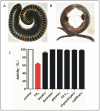Joannsin, a novel Kunitz-type FXa inhibitor from the venom of Prospirobolus joannsi
- PMID: 28276572
- PMCID: PMC6291938
- DOI: 10.1160/TH16-11-0829
Joannsin, a novel Kunitz-type FXa inhibitor from the venom of Prospirobolus joannsi
Abstract
The repugnatorial glands of millipedes release various defensive chemical secretions. Although varieties of such defensive secretions have been studied, none of them is protein or peptide. Herein, a novel factor Xa (FXa) inhibitor named joannsin was identified and characterised from repugnatorial glands of Prospirobolus joannsi. Joannsin is composed of 72 amino acid residues including six cysteines, which form three intra-molecular disulfide bridges. It is a member of Kunitz-type protease inhibitor family, members of which are also found in the secretory glands of other arthropods. Recombinant joannsin exhibited remarkable inhibitory activity against trypsin and FXa with a Ki of 182.7 ± 14.6 and 29.5 ± 4.7 nM, respectively. Joannsin showed strong anti-thrombosis functions in vitro and in vivo. Joannsin is the first peptide component in millipede repugnatorial glands to be identified and is a potential candidate and/or template for the development of anti-thrombotic agents. These results also indicated that there is Kunitz-type protease inhibitor toxin in millipede repugnatorial glands as in other arthropods secretory glands.
Keywords: Kunitz-type inhibitor; Millipede; factor Xa; repugnatorial gland; thrombosis.
Conflict of interest statement
Figures






Similar articles
-
Lufaxin, a novel factor Xa inhibitor from the salivary gland of the sand fly Lutzomyia longipalpis blocks protease-activated receptor 2 activation and inhibits inflammation and thrombosis in vivo.Arterioscler Thromb Vasc Biol. 2012 Sep;32(9):2185-98. doi: 10.1161/ATVBAHA.112.253906. Epub 2012 Jul 12. Arterioscler Thromb Vasc Biol. 2012. PMID: 22796577 Free PMC article.
-
Schixator, a new FXa inhibitor from Schistosoma japonicum with antithrombotic effect and low bleeding risk.Biochem Biophys Res Commun. 2022 May 7;603:138-143. doi: 10.1016/j.bbrc.2022.03.005. Epub 2022 Mar 7. Biochem Biophys Res Commun. 2022. PMID: 35287055
-
Amblyomin-X having a Kunitz-type homologous domain, is a noncompetitive inhibitor of FXa and induces anticoagulation in vitro and in vivo.Biochim Biophys Acta. 2016 Oct;1864(10):1428-35. doi: 10.1016/j.bbapap.2016.07.011. Epub 2016 Jul 30. Biochim Biophys Acta. 2016. PMID: 27479486
-
Reversal of anticoagulants: an overview of current developments.Thromb Haemost. 2015 May;113(5):931-42. doi: 10.1160/TH14-11-0982. Epub 2015 Apr 2. Thromb Haemost. 2015. PMID: 25832311 Review.
-
Andexanet alfa for the reversal of Factor Xa inhibitor related anticoagulation.Expert Rev Hematol. 2016;9(2):115-22. doi: 10.1586/17474086.2016.1135046. Expert Rev Hematol. 2016. PMID: 26686866 Review.
Cited by
-
Identification and Characterization of ShSPI, a Kazal-Type Elastase Inhibitor from the Venom of Scolopendra Hainanum.Toxins (Basel). 2019 Dec 5;11(12):708. doi: 10.3390/toxins11120708. Toxins (Basel). 2019. PMID: 31817486 Free PMC article.
-
Peptide OPTX-1 From Ornithodoros papillipes Tick Inhibits the pS273R Protease of African Swine Fever Virus.Front Microbiol. 2021 Dec 3;12:778309. doi: 10.3389/fmicb.2021.778309. eCollection 2021. Front Microbiol. 2021. PMID: 34925282 Free PMC article.
-
Structural, Biochemical Characterization and Molecular Mechanism of Cerastokunin: A New Kunitz-Type Peptide with Potential Inhibition of Thrombin, Factor Xa and Platelets.Protein J. 2024 Aug;43(4):888-909. doi: 10.1007/s10930-024-10226-9. Epub 2024 Aug 2. Protein J. 2024. PMID: 39095592
-
L-Palmitoylcarnitine potentiates plasmin and tPA to inhibit thrombosis.Nat Prod Bioprospect. 2023 Nov 8;13(1):48. doi: 10.1007/s13659-023-00413-z. Nat Prod Bioprospect. 2023. PMID: 37938456 Free PMC article.
-
Characterization of Kunitz-Domain Anticoagulation Peptides Derived from Acinetobacter baumannii Exotoxin Protein F6W77.Toxins (Basel). 2024 Oct 21;16(10):450. doi: 10.3390/toxins16100450. Toxins (Basel). 2024. PMID: 39453226 Free PMC article.
References
-
- Kuwahara Y, Ichiki Y, Morita M et al. Chemical polymorphism in defense secretions during ontogenetic development of the millipede Niponia nodulosa. J Chem Ecol. 2015;41:15–21. - PubMed
Publication types
MeSH terms
Substances
LinkOut - more resources
Full Text Sources
Other Literature Sources
Medical

